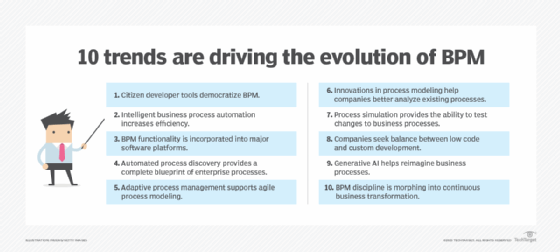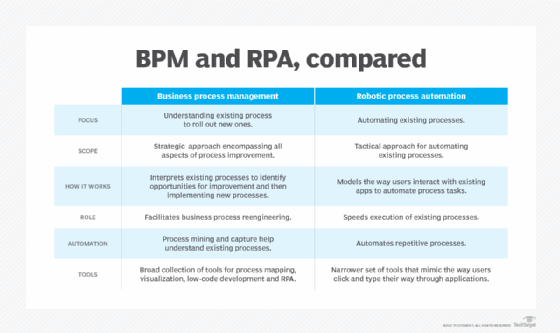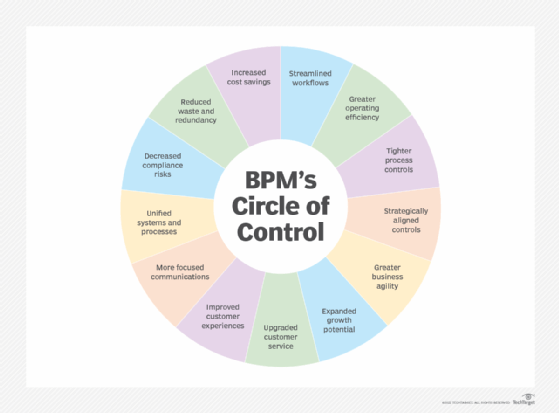business process management software (BPMS)
What is business process management software (BPMS)?
Business process management software (BPMS) helps companies design, model, execute, automate and improve a set of activities and tasks that, when completed, achieve an organizational goal. Taken together, these activities and tasks, which can be done by people and equipment and typically span business departments, make up what is known as a business process. BPM software is the technology product that supports business process management (BPM), a discipline aimed at improving business processes from end to end.
BPMS, sometimes referred to as a business process management suite, is a collection of technologies that includes the following:
- Process mining tools. These are used to discover, represent and analyze the tasks that drive business processes.
- Business Process Modeling Notation (BPMN). BPMN is used to diagram business processes.
- Workflow engines. These automate the flow of tasks that complete a business process.
- Business rules engines. Tools that let end users change business rules without having to ask a programmer for help.
- Simulation and testing tools. These are used to observe how processes behave without having to code first.
In recent years, the market has seen the emergence of the so-called intelligent BPM suite (iBPMS), a term introduced by the research firm Gartner to denote the introduction of sophisticated technologies, such as real-time analytics, complex event processing, business activity monitoring and artificial intelligence (AI). The addition of these technologies made process automation more dynamic and data-driven. These iBPMS products also typically include enhanced mobile, social and collaboration capabilities.
BPMS' increasing use of low-code/no-code (LCNC) technology means that businesses no longer depend solely on professional coders to optimize their business processes. Business analysts and even business users can work together with process developers and IT to discover, improve and transform their business processes using BPMS.

Why use BPM?
BPM assumes that businesses are run by processes and that an effective process is more than the sum of its parts. It recognizes that individual tasks that are optimized to meet the objectives of a specific business unit or organization could nonetheless undercut the goal of the overall business process. Business process management systems aim to support organizational leaders through workflow management and other methodologies to achieve operational efficiencies, while also making the overall process more effective in meeting organizational goals.
BPM isn't a one-and-done project. Instead, it provides a framework for the continual improvement, analysis and creation of business processes, including the ongoing clarification of the job roles and responsibilities of people involved in the process.
If executed properly, BPM improves a company's ability to respond to market trends, threats and opportunities. BPMInstitute.org, the largest practitioner-led community of BPM professionals in the world, states on its website that BPM focuses on end-to-end business processes to achieve three outcomes:
- Clarity on strategic direction.
- Alignment of the firm's resources.
- Increased discipline in daily operations.
Benefits of using BPMS in process improvement programs
According to BPMInstitute.org, implementing a successful BPM program helps enterprises achieve the following:
- Accelerate time to market.
- Improve cost, productivity and quality.
- Improve customer-service levels and satisfaction.
- Streamline business processes.
- Manage risks and meet compliance regulations.
- Introduce new process designs faster.
- Cut costs and increase revenues.
BPMS tools form the operating environment that enables and automates the benefits of BPM described above.
These tools help companies implement their business strategies by coordinating business process change and improvement across departments and even with external partners. They enable integration across enterprise systems and enterprise applications, such as enterprise resource planning (ERP) and customer relationship management. BPMS tools collect data and run analytics to help companies ascertain which parts of the business process can be automated or changed.
Deployed correctly, these tools also automate manual tasks, address process bottlenecks and provide greater visibility into how work tasks fit into a larger process. All of these can help improve employee productivity and morale.
BPMS is considered one of the technologies that helps companies achieve their digital transformation initiatives by providing tools that optimize existing business processes and help create new ones.
Features of BPMS
Standard features found in BPMS include the following:
- Process engines for modeling processes and web applications.
- Data collection and business analytics to enable smart process changes.
- Content management systems for securely storing files.
- Collaboration tools, including social collaboration software.
- Cloud or on-premises deployment.
- User interfaces.
The feature sets of BPMS products are evolving rapidly as vendors respond to customers' need to automate both complex and simple processes. They make changes in real time and use emerging technologies, such as robotic process automation (RPA) and AI, to gain a competitive edge.
Dan Morris, a BPM expert and managing principal at Wendan Transformation Consulting, has written on BPM tools. He described the ideal BPMS architecture as a "composite environment" that can "support very rapid change, be technology-agnostic, support automated application generation and allow applications built in any platform to be seamlessly integrated into the solution."
Forrester Research took note of the evolving nature of BPMS in its 2019 Forrester Wave report on BPMS vendors, describing the market as "in transition" and noting that most vendors have dropped the BPM moniker because of its association with "expensive, complex projects that took many months, if not years, to demonstrate value." The consultancy renamed BPM as digital process automation (DPA) and divided it into two types: DPA deep to describe BPMS' traditional focus on automating complex processes and DPA wide to refer to process automation that's simpler, broader and less expensive.
According to Forrester, companies in the market for DPA deep capability should look for BPMS vendors that can do the following:
- Handle "complex, long-running processes across multiple variables, like local [regulatory] requirements and security," as well as support for high-volume transactions.
- Provide support for emerging technologies, like RPA and AI, which may require "building, acquiring or deep partnering."
- Offer "a modern application architecture" that accommodates cloud-first customers and includes support for the microservices and serverless computing increasingly utilized by process developers.
In addition to being able to handle complex, long-running business processes and incorporate emerging tech, modern BPMS products also feature LCNC development platforms that can be used by professional developers and business users alike to optimize business processes.

Examples of business processes used in BPMS
Business processes that BPMS tools can improve have at least one of these characteristics: They span departmental boundaries, rely on multiple technologies, are bound by compliance requirements and regulations, are long-running and are prone to frequent change. They also fall neatly within different types of business process management, like human-centric or document-centric BPM.
Use cases where BPMS systems can improve business processes include the following:
- Account management.
- Budget tracking and management.
- Claims management.
- Compliance management.
- Customer orders.
- Employee onboarding.
- Inventory management.
- Document management.
- Invoice processing.
- Business performance monitoring.
- Project and workflow tracking.

BPMS vendors and markets
BPMS tools that were popular a few decades ago in the days of service-oriented architecture have given way to more nuanced BPM capabilities built on cloud platforms. Key advances include improvements in automating workflows, new ways to build process models and better capabilities for translating BPMN and BPM+ models into running processes and software applications.
The evolution has been years in the making, said Donncha Carroll, partner at Lotis Blue Consulting. "A decade ago, iBPMS vendors started to add AI, advanced analytics and reporting to their solutions, making them more 'intelligent,' but these systems were inflexible, required a lot of support from IT and developers and became more challenging and costly to maintain over time," Carroll said.
Now, more companies are choosing cloud-based software-as-a-service BPM platforms that incorporate low-code functionality and require little or no involvement from IT. This has shifted control from technical resources to business process owners and managers. The result is more people can access BPMS and increase the scope of what can be done. Modern BPMS removes the translation layer between the business problem and delivering the right BPM solution.
Along with these technical improvements and the democratization of BPM, BPMS tools have expanded their traditional focus on efficiency and cost reduction to also address employee and customer experience enhancement. This makes BPMS an integral part of the digital transformation initiatives many businesses are investing in today.
Another recent development is the incorporation of BPM features in major software solutions. Buyers should be aware that enterprise software platforms that include BPM capabilities tend to be narrower in scope in what they can manage than BPM-specific tools, according to Carroll. As process complexity increases, ERP systems with BPM capabilities become less valuable because the functionality they provide is more limited, he said.
Categories of vendors that offer evolved BPMS products
Many traditional BPM vendors have evolved their platforms to take advantage of modern architectures, LCNC development, RPA, process mining and AI capabilities. Vendors have deployed BPMS capabilities in the following three ways:
- Established BPM vendors that have modernized their offerings include Abbyy, Appian, Bizagi, IBM, Oracle, Pega and Tibco.
- Enterprise software vendors that have added BPMS capabilities through acquisitions or product development include Microsoft, SAP and ServiceNow.
- Open source BPMS vendors that have built BPM-related capabilities on open source software tools for modeling and implementing business processes include Bonitasoft, Camunda, ProcessMaker and Red Hat.
Workflow software vendors are also extending their core workflow automation, optimization, description and management capabilities. They're doing this to support more rigorous business process descriptions, while ensuring ease of use for other users. Examples include BP Logix, Kissflow, Nintex, Webcon and Zoho.
While BPM software can be an important asset for businesses, business process management also poses challenges. Find out about BPM challenges and how to solve them.





